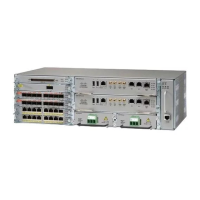▀ Layer 2 Protocol Peering
▄ Cisco ASR 903 Router Design and Deployment Guide
Layer 2 Protocol Peering
To peer with a neighbor on a port that has an EFP service instance configured, you need to configure l2protocol
peer under the service instance.
• Layer 2 protocols peering enables protocol such as CDP, UDLD, LLDP, MSTP, LACP, and DTP on a port which
has EFP configured to work with neighbor.
• CDP, MSTP, LLDP, ELMI and LACP are currently supported on ASR903.
• Layer 2 protocols use untagged frames.
Choose a bridge domain number not being used by other EFPs to have CPU process protocol packets.
interface GigabitEthernet port number
service instance instance id ethernet
encapsulation untagged ! matches untagged frame
bridge-domain {bd number}
l2protocol peer [ l2protocol options ]
The following example enables LACP peering.
interface port-channel1
service instance 1 ethernet
encapsulation untagged
bridge-domain 10
l2protocol peer lacp
Important: The lacp keyword is optional in the last command, without it, it enables all the layer 2
protocols.
Spanning-Tree Configuration
MSTP is supported under EFP bridge domains. MSTP is recommended to be enabled to prevent loop, and it is
disabled by default. RSTP is supported for MST instance 0 only.
• Per-vlan STP is not supported on ASR903.
• All incoming VLANs (outer-most or single) must belong to the same MST instance or loops could occur.
• Backup EFPs must be mapped to the same MST instance as active EFPs.
• Spanning-tree mode mst is to enable MSTP for EFPs and all the EFPs are default to instance 0 unless specified
otherwise.
• L2 protocol peering is needed for devices to use MSTP with neighbor device.
Now another trunk link is added between two PE routers, and spanning-tree should be enabled to prevent loop.

